The City of Portland Bureau of Transportation and TriMet are discussing the idea of installing shared lane markings (a.k.a. sharrows) on the entire length of the new downtown transit mall.
Sharrows are a type of pavement marking that are placed on streets with relatively heavy and/or high motor vehicle speeds, where there is not sufficient space to put a bike lane, and where bikes and cars share the same travel lane (for more on sharrows, see this fact sheet published by PBOT).
Michelle Poyourow, an advocate with the Bicycle Transportation Alliance (BTA) floated the idea to City engineers last fall. Like many in the community, Poyourow is concerned that the configuration of lanes in the new transit mall — bikes and cars will share one, narrow lane, directly adjacent to light rail and buses — might present safety issues.
“Even things that used to be considered ‘cheap’ and could be paid for out of the margins of the budget, like sharrows, look pricey this year.”
— Michelle Poyourow, BTA
Poyourow told us that both PBOT and TriMet liked the idea but concerns have surfaced over funding.
City traffic engineer Rob Burchfield confirmed yesterday that they are “discussing” the idea. In response to questions about it, Burchfield said that the “concept has merit” and that the transit mall, “would be an appropriate place to use sharrows”.
According to Burchfield, the sharrows would not be installed as part of the mall project. This is because they are not in the official plans, they have no identified funding source (more on that below), and they are still considered “experimental” by the FHWA (although they are expected to shed that label when/if they are included in the all-important Manual of Uniform Traffic Control Devices in 2009).
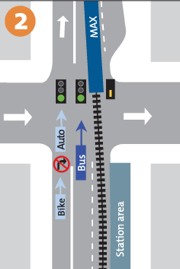
“Auto-Bike” lane.
(Graphic: PortlandMall.org)
City bike coordinator Roger Geller has also been involved with the discussion. He says the plan would be to place sharrows on the entire length of the mall. On SW 6th Avenue, they’d go from Irving to Jackson Streets, and on SW 5th, they’d go from Irving to Jefferson.
Unfortunately, it seems like severe budget woes at PBOT have stymied the plan for now. Several sources at PBOT have expressed that the budget situation (a shortfall of $6.4 million and growing) is the worst they’ve ever seen.
The estimated cost of the sharrows is a paltry $20,000, but apparently even that amount is a potential deal-breaker at PBOT these days. Poyourow says the Bureau is under “serious budget constraints at the moment, so that even things that used to be considered ‘cheap’ and could be paid for out of the margins of the budget, like sharrows, look pricey this year.”
The discussion seems to have stalled for the moment, but the sharrows could be installed in the future. Poyourow is hopeful; “I hope that PBOT can find the money this year to put them down and make it a complete street.”
She points out that sharrows are already in the plans for a Bureau of Environmental Services project on SE Clay Street (PBOT has been piggy-backing on BES “green street” projects for a while now). However, she says the inclusion of sharrows in that project is also “pending PBOT approval”.
— As TriMet gets closer to opening the new transit mall, we will be reporting on this and a number of other issues (many people have crashed when their bike tires catch rail lines). The mall is slated to open in the fall.


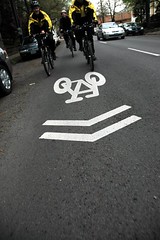
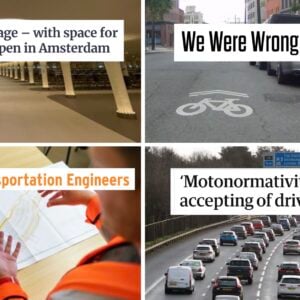
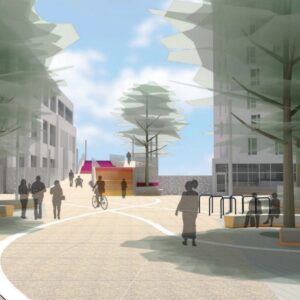
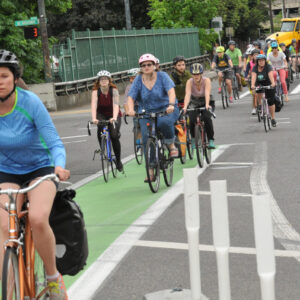
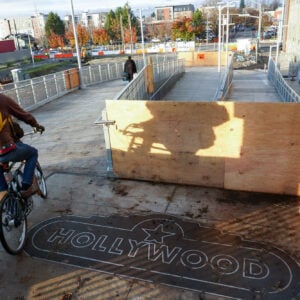
Thanks for reading.
BikePortland has served this community with independent community journalism since 2005. We rely on subscriptions from readers like you to survive. Your financial support is vital in keeping this valuable resource alive and well.
Please subscribe today to strengthen and expand our work.
I don’t see how PBOT can’t put in sharrows, despite the budget shortfall. It’s cheaper than a lawsuit.
The people catching tires in the rail lines shouldn’t even be happening because, technically speaking, cars and bikes are only allowed in lanes where the rail is not. The sharrows would help clarify this for everyone.
See: http://www.portlandmall.org/news/mallsafety.htm
I still have hope that PBOT will simply ban all private motorized vehicle traffic through the transit mall.
The transit mall redesign confounds me. I simply cant understand the meandering max lines (one jusification I read was that both east and west street side merchants wanted boarding stations to alternate, but with the car lane, that can’t happen). Train / bus / everyone else seems better thatn train and bus / everyone else.
I understand the want for sharrows, but question the need in this particular application. Anyone riding from South to North will easily equal auto traffic speed through the transist mall given the downward slope. Likewise, North to South traffic will likely flow smoothly given traffic light timing downtown.
Hey! how come the police officers in that photo are riding on the streets? I’ve only seen them riding on SIDEWALKS!
I’d like to see signs that make it clear that there is NO PASSING in the mall. The lanes are far too narrow to allow cars to squeeze by bikes without going into the transit lanes, besides car speeds should be low in the transit mall to help prevent deaths and injuries of pedestrians as well as cyclists.
Bjorn
I agree with dsaxena; the transit mall should be restricted to tri met & bikers; move all cars to broadway or 4th
I thought that it was already legal for cyclists to use the car lane when there is no bike lane. Wouldn’t this prop up the false notion that bikes are only allowed on designated bike routes?
Hotels and the Portland Business Alliance fought to reintroduce cars to the transit mall with this latest renovation. I doubt they’ll give that up very easily.
Apparently these street markings are important if the plan is to spend $20,000 on paint to put them there. Isn’t there an easier, cheaper way? Such as some signs for example? Maybe even banners like the city attaches to the light poles for the Rose Fest and what not.
Seems like the city and Tri-Met’s major concern is to discourage people from crossing over the MAX tracks. People are probably going to do that anyway.
$20,000 seems expensive for some strip paint. What else goes into this fee?
I would assume that two men could install sharrows for the entire bus mall in one or two days.
It would be nice to see a little fee breakdown instead of just a “Oh crap, I have no idea… well, $20k sounds good” when coming up with the cost for the sharrows.
@ Scott (#3),
I am one of the officers in the photo…I think we were joining one of Roger’s Bike Master Plan rides, but I can’t remember for sure. For more information about why police ride on sidewalks, check this article:
http://bikeportland.org/2007/01/23/guest-post-why-cops-ride-on-sidewalks/
I assume that the Sharrows wouldn’t be paint but would be the thermaplast (sp?) that is used for the bike boxes, etc. You also have to consider the cost of labor in this process which combined adds up quickly. I’m still not sure of Sharrows. I think they confuse drivers more than anything else and even if they are better understood with education, aren’t we simply saying that drivers should be more aware of cyclists when sharrows are present? Isn’t the goal to always have them aware of us? I’d like better data on sharrows. If anyone has it can they share? Have the helped on NW 18th/19th?
I’m from Seattle and would like to chime in here regarding Sharrows since Seattle is enamored of them and is installing them frequently. IF INSTALLED WELL, which means LARGE Sharrows covering the ENTIRE LANE. Seattle has a tendency to install Sharrows to the minimum requirement, which is something like 11′ from the curb, no matter how wide the roadway, and 3″ (?) minimum Sharrow marking width. So many of our Sharrows are small and placed on the right side of the street, directly adjacent to the door zone or even underneath parked vehicles.
There are several areas where Sharrows seem to work well, like on Western Ave, and for me have reduced conflicts with traffic; they seem to act like a kind of “legitmizer” for bikes on the roadway. Installed poorly (like on 4th Ave) they are no better than confusing for everyone.
Booo!
Dear City of Portland,
Please stop pretending to be bike friendly by installing half baked ideas like sharrows.
Easy solution: Cycle Track
Reponse to comment #1: Re:wrecking on the rail lines. Right now, the portion of the mall that doesn’t have rail tracks on it has parked cars on a good portion of it. Some days, including the day I wrecked in the tracks, construction crews block portions of the mall, making for a hairy trip down 5th.
I agree that once they clear the parked cars, travel along the mall will be easier. I would rather share a lane with cars than a train w meandering tracks any day.
Checked the transit site and they are supposed to clear parking on portions soon, so training can start. I think I will keep walking my last few blocks along 5th until the training is over!
Northbound, just take the lane…its all down hill.
Southbound, just take the lane…its not that steep to Jefferson, then there is a bike lane.
Bikers can “own the Mall” if we ride it in numbers, regardless of paint. PDOT should put it on their bike maps as THE N/S route thru downtown.
As useless as i really see sharrows being, I think we should charge Tri Met for the cost 100%.
If it was not for Tri Met “running” those blocks, we would not need warning signs.
Also, give up on the sharrows already.
Use a damn eye level street sign, not some feel good, on road symbol that the majority either do not understand, or find convenient to ignore.
I can’t believe many of you are still backing the sharrows, especially those of you supposedly in charge of things.
The cost differential between Sharrows and a cycle track is huge. Don’t get me wrong, I wholly embrace major arterial cycle tracks and think they fit perfectly into the long-term infrastructure model. This reminds me of Obama’s rhetoric about spending money on valuable long-term projects that put people to work.
Given that sharrows are the only thing on the table at the moment, and tenuous at that, I would like to second what Al(#12) says about sizing. The sharrows need to be huge and placed where the bikes should be, dead center of the lane. If motorists cannot fit, let’s not roll nearish the edge to make it seem possible. As I’ve said in many posts, ambiguity for motorists and cyclists as well is the cause of much risk and stress on our roadways. Do not pass signs are also a really good idea.
In terms of the $20k cost. I would venture to guess that there are plenty of able volunteers that would jump at the opportunity to help. Sure you need a pro to run the lamination tools but there have to be some basic tasks that could be done. I’m one such potential volunteer… I’ll even bring coffee!
Great more plastic crap in the river, what a great idea. Sharrows convey a message that should be obvious to every driver and cyclist that travels though here: Slow down, be careful and respectful, it is a narrow freaking road with a lot of traffic.
Here’s my take on the sharrows. I think it will encourage the more neophyte and timid bikers to take the freaking lane!
I can’t believe how many bikes I’ve seen in the last couple of weeks riding through all the gravel crap because they don’t realize they should take the lane when it’s unsafe to do otherwise.
In the case of the mall, it would discourage ignorant bikers from trying to allow autos room to pass (give ’em an inch and they’ll attempt to take it). I see bikes trying to share the lane all the time on certain downtown streets that are too narrow.
What exactly is the point of sharrows?
Is it to tell car drivers they should share the lane? Shouldn’t they know to do that already? And I agree with Quincy #7: this might lead drivers to get mad when someone is riding on 4th street.
Or is it to tell bicyclists that this street has been optimized for bicycle travel? Has it? I know on Morrison and Yamhill, the street is actually worse for bicycle travel than the streets parallel to it: The lights are not timed for bicyclists, the train gets a green (white) signal before you get a green light, and so while cars can catch up to the green wave after that, unless you are in very good shape, you’ll end up missing a few of the greens as you try to go uphill on a bicycle, because you just can’t accelerate fast enough to catch up to the next green light. 5th and 6th will have the same signal rules, (train gets a green before you do.) Also, the traffic tends to move a lot slower, because every time anyone turns off the street, they have to stop and wait for the pedestrians crossing at the crosswalk there, (and it is the transit mall, so there are a lot of pedestrians,) which holds up traffic for everyone behind them because the cars can’t switch lanes and go around the turner without going into the bus lanes. The only thing that I really see going for 5th and 6th is brand new pavement, and unfortunately, that won’t last forever.
The city engineers should have to read these public comments as their homework.
Here is what that street needs to prevent an immenent cyclist or pedestrian death:
Signs all over that say
a) no idle or parking allowed
b) share the full lane with bikes
c) speed limit 20mph at all times
d) sharrows painted on the road
I’m in Corvallis where we have sharrows on several streets in our few blocks of downtown. I tend to agree with John – #19 and Al – #12 in that they legitimize taking the lane and give tentative bikers permission to do what they’re already entitled to do. They also seem to encourage bikers to ride the sharrow marked streets and stay off the parallel north/south couplet that’s the main artery through town.
I rode through our downtown today on some errands. As pavement markers with no eye level signs, the sharrows aren’t very obvious to motorists.
Finally, ours appear to be painted rather than laminated. $20K? I hope not!
Engineers and business owners cry wolf and say the sky will fall if cars can not drive on the transit mall. Our city council is their lap dog, and soon the price will be death on the mall.
I say wake up.
Think outside the frekin box! It is so simple.
Delivery vehicles, cabs and tour busses can more easily service businesses by using the cross streets. Converting car curbside parking into truck/tour bus spots can triple the shared resources for commercial vehicles.
All the nearby curb street parking spots for cars are a huge asset that is wasted on one single driver. The city needs to take them away from single drivers and give them to the higher turnover commercial traffic!!!
People can still drive their car, park in a lot and then shop and get their parking validated. It is common sense to tax the single car driver the most because their mode of transit is the most costly when it comes to maintaining a city center.
I, for one, do not intend to use the transit mall as a North-South route when it’s finished. I have maintained for over a year with anyone who’ll listen that the design’s a nightmare. Asking cars and bikes to share the same lane will have simply disastrous consequences.
I’ll stick with the bike lanes on Broadway and 13th to get where I ned to go in town.
My concern about sharrows is whether motorists will think that streets with sharrows are the only streets where bicyclists are allowed to take the lane. That said, I think on the transit mall, it would be a good reminder to all that it is expected in that area. Regardless of sharrows, I figure that taking the lane in downtown Portland is the only sane approach.
Simple: Change the speed limit for autos to 5mph downtown. Enforce with the red-light cameras which also detect speed.
Sharrows do seem to work where I have used them. They should be painted on every street where there is no bike lane, since drivers education classes apparently fail to educate in regard to bikes.
How about painting them on the Sellwood bridge- that would make my commute easier.
I mostly don’t see the need for sharrows for a lot of reasons, however it is a good direction indicator incase an out of towner were to attempt a wrong direction turn which would possibly turn ugly before he corrected himself. that would also help serve as a deterant for bicycles that feal it is ok to ride the wrong way on a one way street (bicycle messengers, short cut Annies, thrill seekers…)
I drive up 6th quite often and find it flows well enough that even if you are behind a bike for a long distance it is just fine. I havn’t noticed if there are any pull off areas to allow cars to pass or not?
Beth H.,
You are correct, the new Transit Mall design is a nightmare.
Beyond refusing to use it, it should not even be there in the first place.
What with a few perfectly good rail right of ways heading south where the new trains will go, Tri Met did not need to run a single new train through downtown. It could all have been done south from the Rose Quarter.
But beyond Tri Met being the problem, The City Of Portland allowed this project to happen, green lighting it early, and letting Tri Met continue to do whatever the hell they want with downtown, as it appears.
I personally plan to ride the transit mall, in the car, bus, and rail lanes.
It is my street, and I will let the trains and buses line up behind me.
Icarus (#29)
“It is my street, and I will let the trains and buses line up behind me.’
Have you actually looked at the transit mall design?
“I personally plan to ride the transit mall, in the car, bus, and rail lanes.”
No you won’t. You are blowing hot air. I know that because it would be very inconvenient for you, as a cyclist, to weave across the lanes like that.
My prediction: you will do that once, face plant on the tracks, dust yourself off, realize that no one noticed your little “protest,” or cares for that matter, and then you’ll use the left lane like everyone else. Am I wrong?
“What with a few perfectly good rail right of ways heading south where the new trains will go, Tri Met did not need to run a single new train through downtown. It could all have been done south from the Rose Quarter.”
The same can be said of a bicycle route. The East Bank Esplanade is a great bike route, much better than 5th and 6th. Yes, it might be a mile from your destination, but I’m sure that nobody cares about that, the Esplanade goes north and south, and so do 5th and 6th, so it is all good…
#26 “5 mph limit for cars.” Really!? How slow do you ride? I’d be fine with a 20 mph for cars limit as long as it’s enforced, otherwise, drop it to 15 at worst.
Most riders can sustain 11-15 mph with very little effort and at that speed, you’re hardly plugging the lane in traffic downtown.
5 mph is barely faster than walking and is slower than running. No, thanks, I don’t need cars impeding me any more than they already do.
The shared lane markings are also called chevrons. More information is here:
http://en.wikipedia.org/wiki/Chevron_(insignia)#Bikeway_pavement_markings